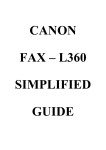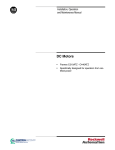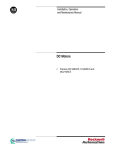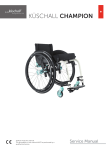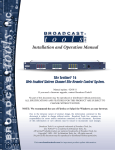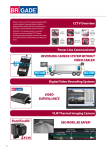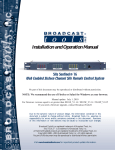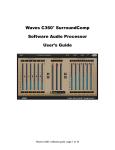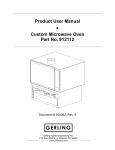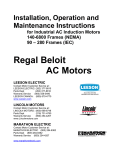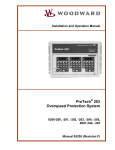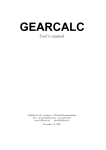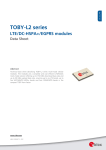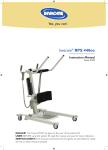Download AC Induction Motors Installation, Operation and Maintenance Manual
Transcript
Installation, Operation and Maintenance Manual AC Induction Motors • Frames L180 - L440 • Specifically designed for use with Adjustable Frequency AC Drives 2 AC Induction Motors General Description The motors described in this publication are high performance motors specifically designed for use with adjustable frequency drives. The basic design includes Class H insulation, 1.0 service factor, 40 degree C ambient, continuous duty. Standard enclosures are totally enclosed blower cooled, totally enclosed fan-cooled, non-ventilated and dripproof force ventilated. Modifications and accessories are available. Important: These motors are equipped with metric hardware. ! Table of Contents ATTENTION: Only qualified electrical personnel familiar with the construction and operation of this equipment and the hazards involved should install, adjust, operate, and/or service this motor. Read and understand this manual in its entirety before proceeding. Failure to observe this precaution could result in personal injury or loss of life. General Description Receiving and Handling . . . . . . . . . . . . . . . . . . . . . . . . . . . . 3 Installation Location . . . . . . . . . . . . . . . . . . . . . . . . . . . . . . . . . . . . . . . . 4 Drain Plugs . . . . . . . . . . . . . . . . . . . . . . . . . . . . . . . . . . . . . 5 Power Supply . . . . . . . . . . . . . . . . . . . . . . . . . . . . . . . . . . . . 5 Conduit Box . . . . . . . . . . . . . . . . . . . . . . . . . . . . . . . . . . . . . 5 Mounting . . . . . . . . . . . . . . . . . . . . . . . . . . . . . . . . . . . . . . . 5 Stub Shaft Installation Procedure . . . . . . . . . . . . . . . . . . . . 6 Connections . . . . . . . . . . . . . . . . . . . . . . . . . . . . . . . . . . . . . 7 Grounding . . . . . . . . . . . . . . . . . . . . . . . . . . . . . . . . . . . . . . 9 Drive . . . . . . . . . . . . . . . . . . . . . . . . . . . . . . . . . . . . . . . . . . 9 Encoder Connection Diagrams . . . . . . . . . . . . . . . . . . . . . 10 Motor Application Data Maximum Safe Speed . . . . . . . . . . . . . . . . . . . . . . . . . . . . 11 Minimum V-Belt Sheave Diameters . . . . . . . . . . . . . . . . . . 12 Shaft Extension and Method of Drive . . . . . . . . . . . . . . . . 12 Shaft Loads - Axial and Radial . . . . . . . . . . . . . . . . . . . . . 13 Operation Motor Start-Up . . . . . . . . . . . . . . . . . . . . . . . . . . . . . . . . . . 14 Balance . . . . . . . . . . . . . . . . . . . . . . . . . . . . . . . . . . . . . . . 15 Maintenance Lubrication - Frames L180 - L400 . . . . . . . . . . . . . . . . . . . 17 Repacking Bearings or Greasing New Bearings . . . . . . . . 18 Disassembly and Reassembly Instructions Axial Float . . . . . . . . . . . . . . . . . . . . . . . . . . . . . . . . . . . . . 19 Anti-Friction Bearing Assemblies . . . . . . . . . . . . . . . . . . . . 19 Bearing Replacement . . . . . . . . . . . . . . . . . . . . . . . . . . . . 20 Bracket Re-Assembly . . . . . . . . . . . . . . . . . . . . . . . . . . . . 20 Stub Shaft Removal Procedure . . . . . . . . . . . . . . . . . . . . . 20 Replacement Bearings/Spare Parts . . . . . . . . . . . . . . . . . 21 Parts Identification Drawing . . . . . . . . . . . . . . . . . . . . . . . . 22 Total Service Programs . . . . . . . . . . . . . . . . . . . . . . . . . . . 22 AC Induction Motors Receiving and Handling 3 Acceptance Thoroughly inspect this equipment before accepting shipment from the transportation company. If any of the goods called for in the bill of lading or express receipt are damaged or the quantity is short, do not accept them until the freight or express agent makes an appropriate notation on your freight bill or express receipt. If any concealed loss or damage is discovered later, notify your freight or express agent at once and request him to make an inspection. We are willing to assist you in collecting claims for loss or damage in shipment; however, this willingness on our part does not remove the transportation company's responsibility in reimbursing you for collection of claims or replacement of material. Claims for loss or damage in shipment must not be deducted from the invoice, nor should payment of the invoice be withheld awaiting adjustment of such claims, as the carrier guarantees safe delivery. If considerable damage has been incurred and the situation is urgent, contact the nearest Allen-Bradley Sales Office for assistance. Please keep a written record of all such communications. Handling ! ! ATTENTION: Eyebolt(s) or lifting lug(s) are intended for lifting the motor only with the standard accessories such as tachometer, brakes, etc., mounted by Allen-Bradley. The lifting means on the motor must not be used to lift the unit plus additional equipment. Failure to observe this precaution could result in personal injury. ATTENTION: Eyebolts may unscrew during lifting. Verify that eyebolts are tight and secure from turning, or lift the unit on a sling or platform. Failure to observe this precaution could result in personal injury. In all cases, care should be taken to assure lifting in the direction intended in the design of the lifting means. Lift using all lugs provided. Likewise, precautions should be taken to prevent hazardous overloads due to deceleration, acceleration or shock forces. Angle of lift with rope or chain must be greater than 45 degrees from horizontal. For unusual conditions, such as side-wall and ceiling mounting of horizontal motors or installation of vertical motors shipped in a horizontal position, special precautions must be taken. It is recommended that an experienced rigger be employed. 4 AC Induction Motors Storage Motors must be stored in a clean, dry area protected from extremes of temperature, moisture, shock and vibration. Storage temperatures of 10 to 49 degrees C (50 to 120 degrees F) with a maximum relative humidity of 60% must be observed. In addition, motors subjected to extended storage must be handled and treated per the requirements specified in publication “Motors-5.0.” This publication is available from your Allen-Bradley Sales Office or online at: http://www.controlmatched.com. All drains to be fully operable while in storage, and/or the drain plugs removed. The motors must be stored so that the drain is at the lowest point. All breathers and automatic “T” drains must be operable to allow breathing at points other than through the bearing fits. Installation Allen-Bradley AC motors are designed and built in accordance with Safety Standard for Construction and Guide for Selection, Installation and Use Of Electric Motors And Generators published by the National Electrical Manufacturers Association (NEMA), publication MG-2-1983 (ANSI C51.5). It is recommended that this publication be referred to whenever you select or install any AC motor. The application of motors and other electrical equipment in hazardous locations is restricted by the National Electric Code. Users must observe these regulations and consult with local code inspection and enforcement agencies to insure compliance. Location Locate the machine where the ambient temperature is not over 40 degrees C (104 degrees F) and where clean air has free access to ventilating intake and outlet openings. Except for machines with a suitable protective enclosure, the location should be clean and dry. Important: The cooling system on standard totally enclosed, blower cooled motors requires clean air to be forced through ducts which are integral to the stator frame. It is important that these air passages be kept clean and that sufficient clearance be provided on the blower motor air inlets and stator duct outlets for unrestricted flow of air. For Drip-Proof Force Ventilated Enclosures, sufficient clearance must be provided on all inlet and outlet openings to provide for unrestricted flow of air. Separately ventilated motors with exhaust to ambient (pipe-in only) must have at least 152.4 mm (6 in.) of clearance between the opening and adjacent walls or floor. Important: Motors located in a damp, moist environment must have space heaters to protect against condensation when motor is not operating. AC Induction Motors 5 Drain Plugs If motor is totally enclosed, it is recommended that condensation drain plugs be removed. These are located in the lower portion of the end-shields (not included on L180 frames). Totally enclosed “XT” motors are equipped with automatic drains which should be left in place as received. Power Supply This is an adjustable speed motor designed for operation with adjustable frequency drives. Verify that the motor nameplate data corresponds to the drive output rating and follow the Drive User Manual for motor installation and connection. Conduit Box The standard conduit box location for totally enclosed motors is top mounted for F1-F2 versatility without motor disassembly. For dripproof force ventilated, F1 is standard. Conduit box can be rotated in 90 degree increments for lead outlet at front, back or sides. On L180 frame motors the conduit box is mounted on the top for all enclosure types. Mounting Motors must be mounted on a rigid, solid base or foundation. Poor base construction may cause resonances in the motor/base assembly which can result in bearing failure and other motor damage. All hold down bolts must be the correct grade for the type of mounting and must be torqued to their recommended value. Table A Recommended Torque Frame L180 L210 L250 L280 L320 L360 L400 Hole Diameter mm (in.) 11.2 (0.44) 11.2 (0.44) 14.2 (0.56) 14.2 (0.56) 17.5 (0.69) 20.6 (0.81) 26.9 (1.06) Bolt Size and Thread 3/8-16 3/8-16 1/2-13 1/2-13 5/8-11 3/4-10 7/8-9 Recommended Torque SAE 5 SAE 8 N-m (lb.-ft.) N-m (lb.-ft.) 45-50 (33-37) 64-72 (47-53) 45-50 (33-37) 64-72 (47-53) 113-126 (83-93) 159-179 (117-132) 113-126 (83-93) 159-179 (117-132) 210-239 (155-176) 271-338 (200-249) 372-420 (274-310) 527-597 (389-440) 588-659 (434-486) 835-934 (616-689) Belted Drive Motor slide bases or rails, when used, must be securely anchored to the foundation with the proper bolts. Important: The motor shaft and load shaft must be parallel and the sheaves aligned. Refer to “Motor Application Data” on page 11. 6 AC Induction Motors Coupled Drive Motors will operate successfully mounted on the floor, wall or ceiling, and with the shaft at any angle from horizontal to vertical. Special mountings, duty or thrust demands may, however, require a different bearing system. ! ATTENTION: Motor C-face is intended for mounting auxiliary equipment such as pumps and gears. When mounted horizontally, C-face motors should be supported by the feet and not by the C-face. Installations requiring horizontally mounted motor frames L280C and L440 must be supported by the feet as well as C-face or D-flange. Failure to observe these precautions can result in damaged equipment and/or personal injury. Stub Shaft Installation Procedure Screw-in Stub Shaft 1. Turn off and lockout power to the motor. 2. Remove in-line blower motor and cover assembly by removing the hex head cap screws on the cover (if enclosure is TEAOBlower cooled). Important: An extended blower cover is required when a feedback device is installed. Contact Allen-Bradley for assistance with an in-line blower. 3. Check the motor shaft center hole for chips, dirt, or other residue and clean as required. 4. Obtain the stub shaft to be screwed into the motor shaft. 5. Apply an even coat of Loctite® Number 271 (or equivalent) to the stub shaft thread. Place stub shaft in motor shaft threaded hole and hand tighten. 6. Using a spanner wrench on the motor shaft drive end (or alternate means of locking motor shaft), torque the stub shaft to 27 N-m (20 lb.-ft.). 7. Using a dial indicator with 0.0005 inch graduations, indicate the stub shaft to within 0.002 inch T.I.R. When Inland tachometers are used, the tachometer stub shafts must indicate to within 0.001 in. T.I.R. 8. Mount feedback device per manufacturer's instructions. AC Induction Motors 7 Connections ! ! ATTENTION: The user is responsible for conforming with the National Electrical Code and all other applicable local codes. Wiring practices, grounding, disconnects and overcurrent protection are of particular importance. Failure to observe these precautions could result in severe bodily injury or loss of life. ATTENTION: This equipment is at line voltage when AC power is connected. Disconnect and lockout all ungrounded conductors of the power line. Failure to observe these precautions could result in personal injury and/or loss of life. Bypass Mode If the motor is to be used in bypass mode, the user must select a motor starter and overcurrent protection suitable for this motor and its application. Consult motor starter application data as well as the National Electric Code and/or other applicable local codes. Contact Allen-Bradley to determine suitability of motor for specific applications in bypass mode. Power Wiring Single Voltage Motors – On Single voltage, three lead motors, connect leads marked U/T1, V/T2, W/T3, to the appropriate drive output terminals. Refer to the Drive User Manual for further information. Dual Voltage Motors – Be sure the motor leads are connected properly for the desired “Low” or “High” voltage connection per the motor connection diagram (see below). Refer to the Drive User Manual for proper drive output connections. 3 PHASE-DUAL VOLTAGE LOW VOLTAGE P1 P2 U/T1 T7 V/T2 T8 W/T3 T9 T4 T5 T6 HIGH VOLTAGE P1 P2 U/T1 V/T2 W/T3 L2 T4 T7 L3 T5 T8 T6 T9 THERMOSTAT LEADS L1 THERMOSTAT LEADS L1 L2 L3 3 PHASE-SINGLE VOLTAGE P1 THERMOSTAT P2 LEADS U/T1 L1 V/T2 L2 W/T3 L3 8 AC Induction Motors Direction of Rotation These motors are capable of bi-directional shaft rotation. When voltages in an A-B-C phase sequence are applied to leads U/T1, V/ T2, W/T3, clockwise shaft rotation facing the opposite drive end will result. If shaft rotation is incorrect, change the direction of rotation as follows: ! 1. ATTENTION: The drive may apply hazardous voltages to the motor leads after drive power has been removed. Verify that the drive is incapable of delivering hazardous voltages and that the voltage at the motor leads is zero before proceeding. Failure to observe this precaution could result in personal injury and/or death. Turn off and lockout all power to the motor. Verify that the voltage at the motor leads is zero. 2. Reverse any two of the three motor power leads. Thermostat Leads (Thermal Protector) As a standard feature, these motors have three (3) normally closed thermostats (one per phase) connected in series with leads P1 & P2 and terminated in the main conduit box. To protect against motor overheating, thermostats must be connected to the appropriate drive circuit (function loss). Failure to connect the thermostats will void the motor warranty. Follow the Drive User Manual for correct thermostat lead connections. Blower Motor Motors which are blower cooled incorporate an independently powered three-phase AC blower motor to assure continuous cooling air flow regardless of motor speed. ! ATTENTION: The blower motor is typically wired to the AC input of the drive and will be energized even when the drive is not running. Remove and lockout the main power supply before touching blower components. Failure to observe this precaution could result in personal injury and/ or death. Blower motor fuse protection kits are required for blower motor overload protection. The specific blower motor will vary depending on frame size and enclosure. Follow the connection diagram supplied with the blower motor, which in general will be one of the following: AC Induction Motors (Delta) T6 T4 T1 T2 L1 L2 Low Volts (Star) T5 T6 T3 T4 T1 L3 L1 Line T2 9 (Delta) W2 T5 T3 L2 L3 High Volts or U1 U2 V1 L1 L2 Low Volts U1 = Black U2 = Green (Star) V2 W2 W1 U2 U1 L3 L1 Line V1 = Blue V2 = White V1 V2 W1 L2 L3 High Volts W1 = Brown W2 = Yellow or Connection Diagram shown on page 7. Procedure: 1. Connect for low or high voltage as shown. 2. Check that the direction of air flow is in agreement with the “direction of air flow” arrows mounted on the motor. If directional flow is incorrect, interchange power leads to T1 & T2 or U1 & V1. Grounding ! ATTENTION: Connect an appropriate equipment grounding conductor to the drive ground terminal, motor frame, transformer enclosure (if used), drive electrical enclosure and an appropriate grounding electrode. Failure to observe these precautions could result in personal injury and/or death. The user is responsible for assuring that the grounding method is in accordance with the National Electric Code and the applicable local codes. The ground connection should be a solid and permanent metallic connection between the ground point, the motor terminal housing and the motor frame. A ground lead is provided inside the terminal box. Due to the need to carry higher frequency ground currents (from switch voltage waveforms) the ground connection/path must be low impedance/low resistance. Such ground currents exist during normal operation on inverter power. Drive L180-L320 frame motors are supplied with a shaft suitable for a belt or coupled drive. Belt loads should be checked against maximum allowable radial loads under “Shaft Loads - Axial and Radial” on page 13. Contact AllenBradley to determine L440 frame belt load requirements. Frames L360S and L400S are suitable for coupled duty only, larger shafts are supplied for belted duty. 10 AC Induction Motors ! ! ATTENTION: Incorrect motor rotation may cause personal injury or damage the equipment. Check direction of motor rotation before coupling motor to load. ATTENTION: Ensure that all guards are properly installed before proceeding. Exercise extreme care to avoid contacting rotating parts. Failure to observe these precautions could result in personal injury. Proper alignment is a key step for long life of bearings, shafts and belts, and minimum downtime. Misalignment can cause excessive vibration and damaging forces on shaft and bearings. For direct coupled drives, flexible couplings facilitate alignment. For belt drives, the sheave must be placed as close as possible to the motor bracket. Shipping Blocks Motors supplied with roller bearings at the drive end are shipped with wooden blocking to prevent axial movement of the shaft during shipment. Remove the blocking and bolts securing it and discard. Make sure motor shafts turn freely. If motor is to be reshipped, blocking of bearing is required. Encoder Connection Diagrams Dynapar H20 – 10 pin M/S Connector 360° 90° ±45° Output Terminations Electrical Output A Output B 360° ±180° Index Output waveform CCW Rotation of Shaft Signal Output A Output B Output Z Vcc Common Case No Connection Output A (NOT) Output B (NOT) Output Z (NOT) Pin A B C D F G E H I J Lakeshore – Epic Connector or Plain Cable The following table is a universal wiring guide for the latching Epic connector or plain cable. Wires that are not used should be left not connected (never connect to power or common). For optimum EMI noise immunity, connect the encoder shield (pin 10 or braid) to the cable shield. The encoder shield is internally isolated from the encoder frame. The cable shield should still be connected to ground at the receiving end. This encoder has a line driver output. A pull-up resistor is not required. AC Induction Motors 11 Epic Connector or Plain Cable Connections Pin 1 2 3 4 5 Motor Application Data Signal Common B A Z No Connection Color Black Green Blue Violet – Pin 6 7 8 9 10 Signal 5-15V B (NOT) A (NOT) Z (NOT) Shield Color Red Yellow Gray Orange Braid Maximum Safe Speed ! ATTENTION: The machinery builder and/or user are responsible for assuring that all drive train mechanisms, the driven machine, and process material are capable of safe operation at the maximum speed at which the machine will operate. Failure to observe these precautions could result in personal injury. The speeds given in Table B are the maximum mechanically safe operating speeds for frames with standard construction. These speeds must not be exceeded under any condition. Motor control must hold the maximum speed under any load condition including no-load within the maximum safe speed. Drive systems whose design characteristics inherently prevent the AC motor from exceeding the motor maximum safe operating speed must prevent the motor from exceeding the maximum safe speed if a single component failure should occur. Table B Maximum Safe Speed Frame Diameter L180 L210 L250 L280 L320 L360 L400 L440 Maximum Safe Speed 7200 RPM 5000 RPM 5000 RPM 5000 RPM 4000 RPM 3750 RPM 3750 RPM 2700 RPM With special construction maximum safe speed may differ from the above values. In all cases, the maximum safe speed is indicated on the motor nameplate. Important: Normal operating speeds must be limited to those listed in order to meet nameplate rating and assure validity of warranty. 12 AC Induction Motors Minimum V-Belt Sheave Diameters Application of Pulleys, Sheaves, Sprockets and Gears on Motor Shafts To avoid excessive bearing loads and shaft stresses, belts should not be tightened more than necessary to transmit the rated torque. The pre-tensioning of the V-belt drive should be based on the total tightening force required to transmit the horsepower divided by the number of belts. This procedure avoids the excessive load caused by tightening individual belts to a prescribed level recommended by belt manufacturers. Mounting In general, the closer pulleys, sheaves, sprockets or gears are mounted to the bearing on the motor shaft, the less will be the load on the bearing. This will give greater assurance of trouble-free service. The center point of the belt, or system of V-belts, must not be beyond the end of the motor shaft. The inner edge of the sheave or pulley rim should not be closer to the bearing than the shoulder on the shaft but should be as close to this point as possible. The outer edge of a chain sprocket or gear must not extend beyond the end of the standard motor shaft. Shaft Extension and Method of Drive Frames L180-L250 are supplied with a shaft and bearing system suitable for either coupled or belted drives. Belt loads should be checked against maximum allowable radial loads under “Shaft Loads - Axial and Radial” on page 13. Frames L280-L320 may be supplied with roller bearings for belt duty applications. Frames L360-L440 are supplied with larger shafts and roller bearings when belted drives are specified. Preferred V-Belt Drives (Sheave Centerline is Toward Motor from End of Shaft) V x d where: d = Minimum pitch diameter of V-belt sheave in inches or millimeters. hp = Rated horsepower at base speed. kw = Rated kilowatts at base speed. x = Axial distance of the sheave centerline from the end of the shaft in inches or millimeters. The distance is measured from the end of the shaft (x is negative if centerline is beyond the end of the shaft and positive if toward the motor.) The formula should not be used for negative values of x greater than one half of the V dimension of the shaft extension. AC Induction Motors 13 Table C Constants for Calculating the Minimum Sheave Diameters for V-Belt Drives Frame L210 L250 L280 L320 UL360 UL400 Units inches “V” Dimension 3.50 millimeters 88.9 inches 4.00 millimeters 101.6 inches 4.50 millimeters 114.3 inches 5.00 millimeters 127.0 inches 6.25 millimeters 158.8 inches 8.00 millimeters 203.2 Constant A B C D A B C D A B C D A B C D A B C D A B C D Base RPM 850 1150 40.6 30.0 7.26 5.43 1384 1022 9.73 7.28 23.33 18.25 3.58 2.3 795 622 4.80 3.08 20.28 16.17 2.94 1.75 691 551 3.94 2.35 18.47 14.25 2.00 1.24 630 486 2.68 1.66 10.42 8.08 0.46 0.25 355 275 0.62 0.34 8.9 6.9 0.30 0.23 303 235 0.40 0.31 1750 19.77 3.56 674 4.77 12.67 1.17 432 1.57 11.2 0.84 382 1.13 9.97 0.59 340 0.79 5.89 0.13 201 0.17 4.8 0.16 163 0.21 2500 14.63 2.09 499 2.80 9.47 0.57 323 0.76 8.32 0.43 284 0.58 – – – – – – – – – – – – Shaft Loads - Axial and Radial These motors are suitable for limited shaft loads as shown in Tables D and E. Recommended maximum thrust loads depend on the mounting position, either horizontal or vertical. For recommendations for loads in excess of those shown, contact Allen-Bradley. Table D Axial Thrust Capacity - No Radial Load Horizontal Mounting Vertical Mounting Units 2500 RPM 1750 RPM 1150 RPM 850 RPM 2500 RPM 1750 RPM 1150 RPM 850 RPM pounds 430 500 600 675 430 ±60 500 ±60 600 ±60 675 ±62 kilograms 195 227 272 306 198 ±27 227 ±27 272 ±27 306 ±27 L210 pounds 477 551 662 742 498 ±61 564 ±61 676 ±61 756 ±61 kilograms 217 251 301 338 227 ±28 257 ±28 308 ±28 344 ±28 L250 pounds 509 600 722 828 541 ±86 629 ±86 755 ±86 865 ±86 kilograms 231 272 327 376 245 ±39 285 ±39 342 ±39 392 ±39 L280 pounds 590 700 850 975 644 ±122 754 ±122 905 ±122 1038 ±122 kilograms 268 318 386 442 292 ±56 342 ±56 411 ±56 471 ±56 L320 pounds 705 835 1020 1170 770 ±175 905 ±175 1095 ±175 1250 ±175 kilograms 320 379 463 531 349 ±80 411 ±80 497 ±80 567 ±80 L360 pounds 875 1075 1350 1525 830 ±293 1020 ±293 1300 ±293 1475 ±293 kilograms 397 488 612 692 376 ±133 463 ±133 590 ±133 669 ±133 L400 pounds 1350 1630 2000 2250 1470 ±352 1820 ±352 2210 ±352 2475 ±352 kilograms 612 740 908 1021 667 ±160 826 ±160 1003 ±160 1123 ±160 L440 pounds 1300 1550 1800 2050 1365 ±1085 1600 ±1085 1865 ±1085 2080 ±1085 kilograms 590 703 816 930 619 ±492 726 ±492 846 ±492 943 ±492 1 Thrust capacity for vertical mounting includes a constant whose value is plus or minus depending on the direction of the thrust load. The constant is plus for thrust loads acting upward against the force of gravity and minus for loads acting downward with gravity. Frame L180 14 AC Induction Motors ! ATTENTION: The use of these radial load capacities requires the accurate calculation of the radial load for the application. Radial loads for gears, sprockets, and flywheel are usually accurately determined but the radial loads due to V-belt drives are subject to miscalculations because they do not include all of the pre-tension load (belt tightening). The calculations of the radial load for a V-belt drive must include the pre-tension for transmitting the horsepower, pre-tension for centrifugal force on the belts, pre-tension for high start torques, rapid acceleration or deceleration, pre-tension for drives with short arc-of-contact between the V-belt and sheave, and low coefficient of friction between belt and sheave caused by moisture, oil or dust. Failure to observe these precautions could result in damage to or destruction of the equipment. Table E Radial Load Capacity - No Axial Load 2 Radial Load Capacities at the End of the Shaft in kg (lbs.) 2500 RPM 1750 RPM 1150 RPM 850 RPM 202 (445) 202 (445) 202 (445) 202 (445) 397 (875) 397 (875) 397 (875) 397 (875) 623 (1375) 692 (1525) 692 (1525) 692 (1525) 703 (1550) 796 (1755) 796 (1755) 796 (1755) 764 (1685) 816 (1800) 816 (1800) 816 (1800) 1157 (2550) 1304 (2875) 1497 (3300) 1501 (3310) 1644 (3625) 1855 (4090) 2132 (4700) 2354 (5190) Frame L180 L210 L250 L280 L320 UL360 1 UL400 1 1 Data for motors with roller bearings at the drive end (back end). Motors with ball bearings at the drive end are for coupled duty only. 2 Contact Allen-Bradley to determine L440 frame belt load requirements. Operation Motor Start-Up ! ATTENTION: Before initial start-up observe the following precautions. • Remove all unused shaft keys and loose rotating parts to prevent them from flying off. Replace covers and protective devices. • When the motor is supplied as part of drive system, refer to the Drive User Manual for operating instructions. Tachometer feedback must be properly connected for closed loop operation. Reverse polarities or broken connections can cause dangerous overspeeds. Failure to observe these precautions could result in personal injury or death. AC Induction Motors 15 In addition to observing the above precaution, all precautions (Attentions) mentioned previously in this document should be observed. • Stop and remove power from the motor per the Drive User Manual directions. • Verify that the DC bus voltage is zero per the Drive User Manual. • The interior of the motor should be clean and dry. • Connections must be tight. • The driven machine should be unloaded, if possible. Important: Machines designed for cooling by a separate source of forced ventilation must not be operated without the air supply. Be sure blower is running in proper direction. While operating the motor, observe the performance. It should run smoothly with little noise. The bearings should not overheat and should reach a leveling off temperature. Any undue noise, overheating, or erratic performance should be investigated and necessary corrective action taken immediately to prevent serious damage. Before attempting any repairs, please contact your AllenBradley Sales Office. All motors are lubricated before shipment and will operate for a long period before regreasing is required. The period will vary depending on environmental and service conditions. Refer to “Maintenance” on page 16. ! ATTENTION: Surface temperature of the motor enclosure may reach temperatures which can cause discomfort or injury to personnel coming into contact with hot surfaces. The user must apply appropriate guards and/or shields to protect against accidental contact with motor surface. Failure to observe this precaution may result in personal injury. Balance Motors are dynamically balanced to commercial limits unless ordered differently. Balance is done with a full length 1/2 height shaft key. A full shaft key is shipped with the motor. Sheave or coupling should be balanced with a 1/2 height shaft key. Standard Dynamic Balance Limits Highest Rated Speed (RPM) 3,000 - 4,000 1,500 - 2,999 1,000 - 1,499 Up to 999 Maximum Amplitude (Inches) 0.0010 0.0015 0.0020 0.0025 16 AC Induction Motors Maintenance ! ATTENTION: Internal parts of this motor may be at line potential even when it is not rotating. Before performing any maintenance which could result in contacting any internal part, be sure to disconnect all power from the motor. Failure to observe this precaution could result in severe personal injury or death. Amount of grease to be added to motors is shown in Table F. See Table H for relubrication interval. Use Chevron SRI-2 or equivalent grease unless motor nameplate specifies special grease. Table F Coupled/Belted or Tandem Duty Grease Amounts Frame L180 - L280 L320 - L400 L440 Volume Cubic Inches 1.0 2.0 3.0 Cubic Centimeters 16 32 48 Weight Ounces 0.5 1.0 1.5 Grams 14 28 42 Using the table below, determine service condition on the basis of the most severe operating parameter (i.e. temperature, bearing load, atmosphere, or operating hours per day). Table G Service Condition Service Condition Ambient Temperature Standard –18 to 40 degrees C (0 to 104 degrees F) Severe –30 to 50 degrees C (–22 to 122 degrees F) 1 Bearing Load Steady Operating Atmosphere Hours/Day Clean 8 Medium Shock, Vibration Medium Dirt, 8 to 24 (less than 0.2 in/sec.) Abrasives, Corrosion Extreme 2 –54 to 65 degrees C Heavy Shock, Vibration Heavy Dirt, 8 to 24 (–65 to 149 degrees F) 1 (more than 0.44 in/sec) Abrasives, Corrosion 1 Motors must be specially designed for operation in ambient outside the range of –25 to 40 degrees C (–13 to 104 degrees F). Special grease is required. 2 "EXTREME" service conditions are rare in actual practice. Corresponding lubrication cycles should therefore be applied with caution. In addition, it is advisable to check with Allen-Bradley for related special instructions. AC Induction Motors 17 Table H Relubrication Periods - Frames L180 - L440 Maximum Normal Operating Speed (RPM) 1 Frame 3450 and higher All 2400 - 3449 L180 - L250 L280 - L440 1700 - 2399 L180 - L320 L360 - L440 UL360 - UL440 800 - 1699 L180 - L320 L360 - L440 UL360 - UL440 500 - 799 L180 - L320 L360 - L440 UL360 - UL440 499 and lower L180 - L440 UL360 - UL440 1 2 Relubrication Interval (Months) Standard Severe Extreme Service Service Service 9 4 1 24 9 3 9 3 1 36 12 3 18 6 2 9 3 1 36 24 8 36 12 3 9 6 1 48 36 12 36 24 8 18 12 4 48 36 12 24 18 6 Maximum speed occupying more than 30% of operating time. For Tandem drives increase frequency of lubrication by multiplying values by 0.8. Lubrication - Frames L180 - L440 These motors are designed to route new grease directly into the bearing. The relubrication periods shown in Table H are offered as a guide for varying service conditions, speeds, bearing types and operating hours. Important: Certain special motors may have a lubrication instruction plate permanently attached. These specific lubricating instruction must be followed. Lubrication Procedure ! ATTENTION: If relubrication is done while motor is running, stay clear of rotating parts. Failure to observe this precaution could result in personal injury. 1. Relubrication with the shaft stationary and a warm motor is recommended. If lubrication must be done with the motor running, stay clear of rotating parts and electrical circuits. 2. Locate the grease inlet at the top of the bearing hub, clean the area and replace the 1/8 inch pipe plug with a grease fitting (if the motor is not equipped with a grease fitting). 3. Remove grease drain plug located opposite the grease inlet. 4. Using a manual grease gun, pump in the recommended grease in the amount shown in Table F. This amount of grease will provide an ample supply of lubricant between lubrication periods as determined from Table H for the service condition listed in Table G. 18 AC Induction Motors Use Chevron SRI-2 grease or equivalent unless motor nameplate specifies special grease. Use only clean, fresh grease from clean containers and handle carefully to keep it clean. In general, mixing of greases is not recommended. If an incompatible grease is used, the lube system must be repacked completely with the new grease. 5. Wipe away any excess grease at the grease drain or relief and replace drain plugs. Repacking Bearings or Greasing New Bearings When existing bearings have been completely cleaned of old grease or when bearings are replaced, use this procedure for packing the bearing. 1. Apply one bead of grease around the inboard side of the bearing, between bearing and inner cap. Assure that grease adheres to balls or rollers. 2. Apply one bead of grease around outboard side of bearing, making sure grease adheres to balls or rollers. 3. Completely fill grease inlet and outlet passage holes with grease. 4. Fill outboard bearing cavity 60% to 90% full of grease. 5. If possible, rotate shaft of assembled machine at least three revolutions by hand to distribute grease within bearings before starting motor. Bearings Bearing housing designs provide protection to windings and interior of machine by minimum grease leakage. They also provide good protection against external contamination. Various types of anti-friction bearings are used in the wide range of frames as needed to meet specific load, speed and service requirements. Most commonly used bearings are: • Single row, open ball bearings for coupled and belted duty for frames L180 - L320. • Single row, open ball bearings for coupled duty for frames L360 and L400. • Cylindrical roller bearings at drive end for belted duty on frames UL360 and UL400. AC Induction Motors 19 Frequent bearing checks are recommended. If temperatures become excessive, investigate immediately for the cause. Total bearing temperatures should not exceed 121 degrees C (250 degrees F). Causes for high bearing temperature are: • Contaminated grease. • Insufficient grease or excessive amount. • Incorrect grease. • Excessive load or thrust due to misalignment or motor overload. • Loose bearings. • Bearing failure. • Excessive ambient temperature. Replacement bearings should be ordered from Rockwell Automation in order to obtain the same carefully selected bearing as the original. Bearings should never be exposed by disassembly of the motor unless absolutely necessary for inspection or replacement of the bearing or maintenance in other parts of the machine. Protect good bearings from dirt and contamination at all times. Most bearing failures are caused by dirt. The open ball bearings for motor frames L180 - L320 are the same regardless of whether application is coupled or belted. Belted duty for frames UL360 and UL440 requires the use of roller bearings. Coupled duty uses ball bearings. Disassembly and Reassembly Instructions Axial Float Motors have a wave spring washer between the drive end bracket and bearing. The opposite drive end bearing is positioned axially by a float restricting inner cap. Axial float (including bearing internal clearance) should be within the limits listed below. The L440 frame spring is located on the opposite drive end. Axial Float Frame L180 - L440 Maximum 1.29 mm (0.051 in.) Minimum 0.33 mm (0.013 in.) Anti-Friction Bearing Assemblies The bearings are positioned and secured in a machined cavity in the end brackets. Open type ball bearings are used for direct coupled and belt drive applications for frames L180 - L320 (employ ball bearings at both ends) and are protected by inner caps at both ends. Frames UL360, UL400 and UL440 employ a cylindrical roller bearing on the drive end for belt drives, and a ball bearing for coupled service. 20 AC Induction Motors Bearing Replacement Remove bearing by means of bearing puller. Clean bearing housing and bearing seat prior to assembly of bearing. Place new bearing in a bake oven for 1/2 hour at 121 degrees C (250 degrees F). Place bearing onto shaft and push home to bearing shoulder. Hold it in place for a minimum of 30 seconds. After bearing has cooled down for about 1 minute, add 1/2 cu. in. of fresh grease into back of bearing. Once motor is assembled, grease bearings per instructions found herein. Bracket Re-Assembly To obtain proper planity between the integral mounting feet on the front and back end brackets of L210-L440 frame motors, a smooth level surface should be used to align the brackets when they are assembled to the frame. Check for proper shaft alignment after reinstalling the motor. Stub Shaft Removal Procedure Drive-in Stub Shaft 1. Turn off and lockout power to the motor. 2. Remove in-line blower motor and cover assembly by removing the hex head cap screws on cover (if enclosure is TEAO-Blower cooled). 3. After removal of blower assembly, obtain the stub shaft puller backplate and assemble over the stub shaft against the end of the motor shaft. 4. Obtain the stub shaft puller plate (available from Rockwell Automation) and assemble over the stub shaft, and up against the puller backplate. Important: Note 7/16 inch set screws must be backed out enough to clear the stub shaft O.D. 1/2 inch jack screws should be backed out to allow puller plate to fit up flush against the backplate. 5. Screw the 7/16 inch set screws in on each side of the puller plate until they contact the stub shaft. Keep the stub shaft reasonably centered between the jack screws. Tighten screws securely. 6. Using a 3/8 inch allen wrench, turn the jack screws, in equal amounts, in a clockwise manner to remove the stub shaft. If the set screws slip, retighten and repeat process. 7. Replace blower motor and cover assembly (if TEAO - blower cooled) with the correct extended blower cover, using the hex head cap screws previously removed. AC Induction Motors 21 Screw-in Stub Shaft 1. Turn off and lockout power to the motor. 2. Remove in-line blower motor and cover assembly by removing the hex head cap screws on cover (if enclosure is TEAO-Blower cooled). 3. After removal of blower assembly, motor shaft will need to be locked from turning. The use of a spanner wrench on motor drive shaft or alternate means can be used. Place an open-end wrench on stub shaft flats and turn counter clockwise (right-hand threads). 4. Replace blower motor and cover assembly (if TEAO - blower cooled) with the correct extended blower cover, using the hex head cap screws previously removed. Replacement Bearings/Spare Parts Your maintenance program will not be complete without including spare bearings. It must be remembered that the bearing is a wearable component and therefore must eventually be replaced. To ensure that you are able to maintain original operation, we recommend the purchase of spare parts directly from Rockwell Automation. All bearings are subject to exact specifications and tests necessary to satisfy performance requirements. In this manner, it is possible to duplicate your present bearing. Markings on the bearing do not indicate complete specifications. A detailed parts list, which gives Allen-Bradley recommendations for spare parts that should be stocked for your equipment, can be ordered from your Allen-Bradley Sales Office. Be sure to include complete nameplate data - serial number, model number, rating, etc. - for your equipment when ordering the spare parts list. 22 AC Induction Motors Parts Identification Drawing Totally Enclosed Blower Cooled Item No. 1 2 3 4 5 6 7 8 9 10 11 12 Total Service Programs Part Description Frame/stator Rotor Bracket, B.E. Bracket, F.E. Shaft Ball Bearing, B.E. Inner Cap, B.E. Ball Bearing, F.E. Inner Cap, F.E. Wave Washer, B.E. Blower Motor Cover, Blower Item No. 13 14 15 16 17 18 19 20 21 22 23 Part Description Grill, Blower Eyebolt Conduit Box, Main Motor Grease Fitting, B.E. Grease Fitting, F.E. Key, Shaft Extension Feedback Device (When Supplied) Connector, Feedback Device Coupling, Feedback Device Mounting Adapter, Feedback Device Blower Motor Conduit Box Allen-Bradley can provide a wide range of maintenance programs to help you reduce downtime, improve productivity and increase profits. Capabilities include: • Motor Start-up Service • Motor Electrical and Mechanical Preventive Maintenance • Vibration Analysis • Mobile Van Repair Service • Balancing and Alignment Service • Maintenance Service • 24-Hour Technical Support • Modernization Service For more information contact your local Allen-Bradley Sales Office. AC Induction Motors Notes 23 Online Documentation The latest motor information can be obtained from the Allen-Bradley Drives & Motors home page on the World Wide Web at: http://www.controlmatched.com Publication 1329L-UM001A-EN-P – July, 2001 Supersedes 1329L-5.0 dated March, 2000 Copyright © 2001 Rockwell Automation. All rights reserved. Printed in USA.
























